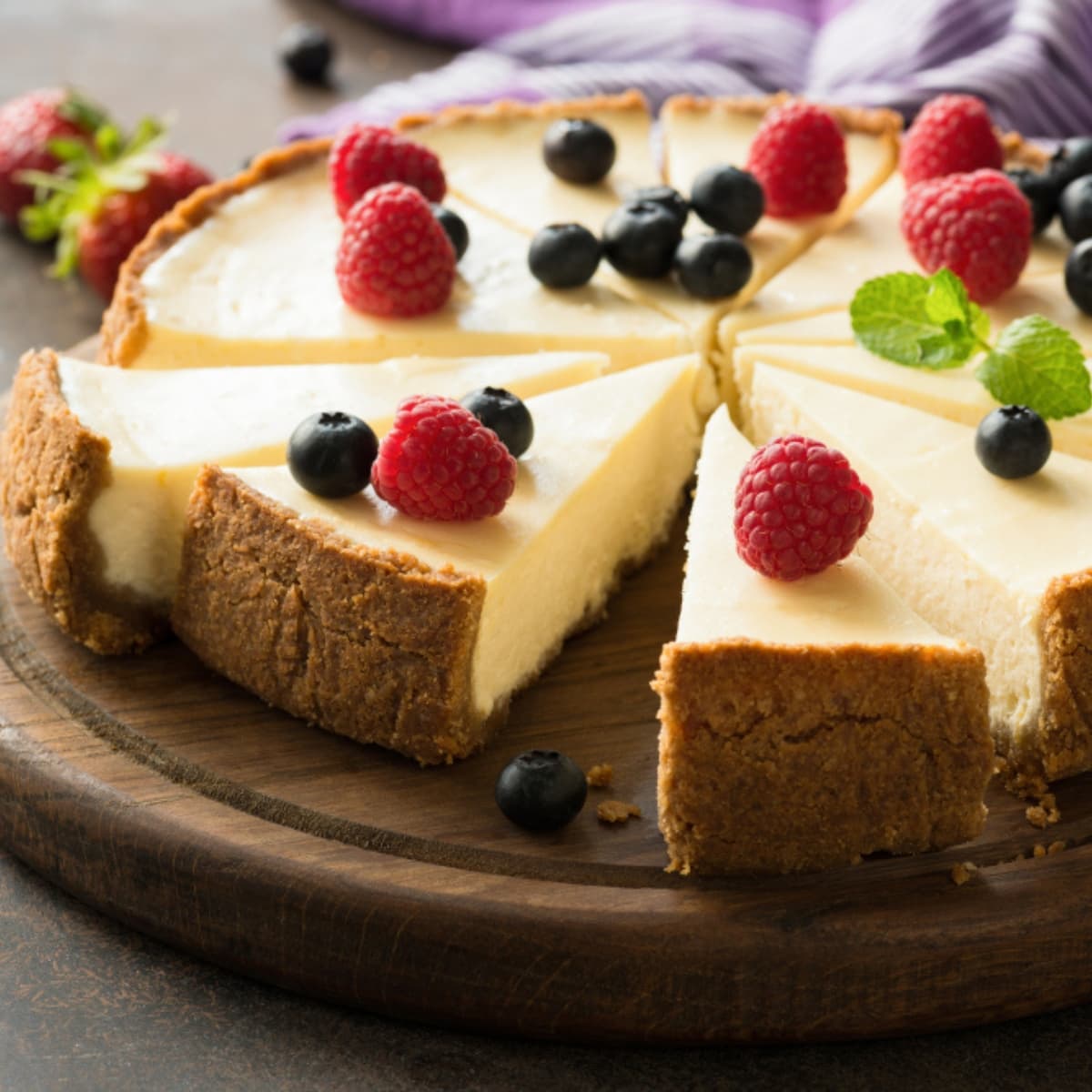You are here to learn how to fix a cracked cheesecake. But unfortunately, the title is a bit of a misnomer. You cannot truly fix a cracked cheesecake.
But there are a few things you CAN do to smooth it out.

More than likely, you found your way here for a reason. And, most likely, you’re staring at a cracked cheesecake. I’m sorry.
Trust me- I’ve been where you are. I’ve felt the frustration and disappointment you are feeling.
The good news is there is still hope! There are a few different ways to hide a cracked cheesecake.
How to Fix a Cracked Cheesecake
Unfortunately, you cannot fix a cracked cheesecake. Once the cracks are there, there’s no reversing them.
But that doesn’t mean everyone else has to see them.
There are a few ways to mask cheesecake crevasses. The one you use depends on the size of the cracks.
Method 1: Smooth Over the Cracks
This method works best for small cracks.
- Grab an offset spatula or a knife.
- Heat about 12 ounces of water.
- Dip your tool into the warm water and use a paper towel to dry it.
- Let it cool until it is hotter than warm but not hot to the touch.
- Then, use the knife or spatula to “sweep” over the crack.
- Continue doing this until the damage smooths and the top is uniform.
It may not remove all evidence of the crack. But it will do enough that most people won’t notice.
Method 2: Add a Topping
Have multiple small cracks, or medium or large ones instead? Don’t get rid of them– cover them up. #cookingconspiracy
- You can coat the cheesecake in chocolate, caramel sauce, or a thick glaze. Cookie butter, Nutella, and peanut butter are also fabulous options.
- To hide small cracks, you can use strategically placed goodies. Fresh fruit, cookie crumbles, nuts, and candy work well.
- Large, deep cracks may require a thicker sauce or even whipped cream to cover them. Chocolate ganache or buttercream frosting are delicious options for these.
Method 3: Press the Sides of the Cake Together
Reserve this method for large cracks. Especially when you cannot (or don’t want to) add a topping.
- Gently squeeze the sides of the cheesecake to push it back together.
This method occasionally works when the cracks are long but not especially deep.
If none of the above methods works for you, don’t panic. You still have one final option left: cut the cheesecake.
- Cut it into individual slices and add some fun decorations to each piece.
No one has to know that you cut the cake because of cracks. Perhaps you only wanted to make serving more convenient! 😉

What Causes a Cheesecake to Crack?
Cheesecakes are delicate and somewhat prone to cracking. However, there are still root causes of the cracking.
Knowing them can help you avoid cracking. So, here are the four most common causes of cracked cheesecakes:
1. Overmixing the Batter
Mixing cheesecake batter is not like mixing muffin batter or bread dough. It doesn’t require any vigorous beating, mixing, or kneading.
Instead, combine the ingredients gently to avoid overmixing. Mixing the batter too much causes air bubbles to form.
As the cheesecake bakes, those air bubbles will release, causing cracks. That’s why it is so crucial that you do not overmix.
2. Over-Baking
Just as you can overmix the batter, you can also over-bake the cheesecake. Remember, you should never bake a cheesecake until it sets.
Instead, remove it from the oven while the center is still somewhat wet and jiggly. It will firm up as it cools.
If you continue baking it until it sets, you risk over-baking it.
When that happens, the excessive heat denatures the proteins in the eggs. That causes cracking.
An over-baked cheesecake also loses all its moisture and dries out. So, aside from the cracks, it doesn’t taste as good or have a nice texture.
3. Temperature Fluctuations
Any time there’s a drastic temperature change, cracking can occur. This can happen if you open the oven too often to check the cheesecake.
Or if you transfer the cheesecake from the oven to a cold environment too fast.
(For example, removing the cheesecake from the oven and putting it directly into the fridge.)
4. The Cooling Process
Unfortunately, the cooling process can also cause cracking.
As the cheesecake cools, it contracts.
If the cake is stuck to the pan, it will not contract smoothly. (The stuck places will pull against the areas trying to contract.) That will lead to cracking.

How to Prevent a Cracked Cheesecake
Luckily, although cheesecakes are delicate, there are ways to prevent cracking.
The first two are simple: don’t overmix the batter or over-bake the cake.
- You can vigorously mix the cream cheese and sugar. In fact, you should vigorously mix them, so that the cheese becomes soft.
- After that, though, mix gently.
- Just barely mix in the eggs, flour, and other ingredients. Just enough to incorporate them into the mixture.
- No vigorous beating or mixing is required once you get to the eggs.
Then, remember to remove the cake from the oven while the center is still jiggly. And never put a hot cheesecake in the fridge to cool.
- Instead, set it on the counter near the stove, where the air is still warm.
- Or you can leave it in the oven. Turn the oven off, and open the door to let in some cooler air.
Remember to release the cake from the springform pan once you remove it.
- Gently run a knife around the edges before you open the spring.
- This ensures that there is no cheesecake sticking to the sides of the pan.
And finally, don’t be afraid to use a water bath. It often scares people away. But it is the best way to prevent cracking in cheesecakes.
Cheesecake Recipes You Have to Try
New York Cheesecake
Oreo Cheesecake
Lemon Cheesecake
White Chocolate Cheesecake
Woolworth Cheesecake











